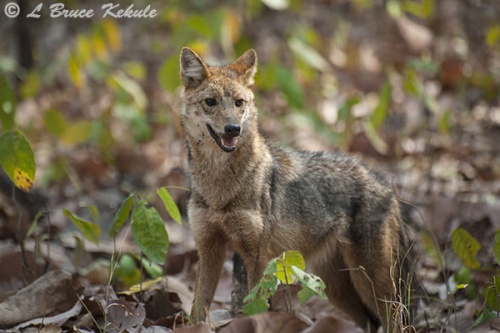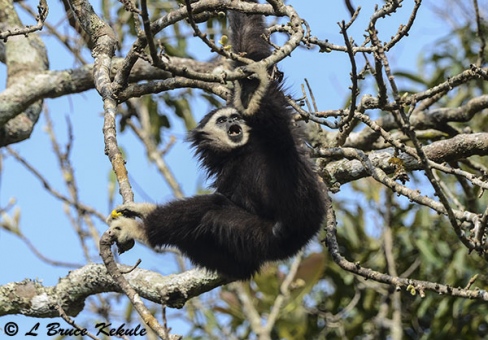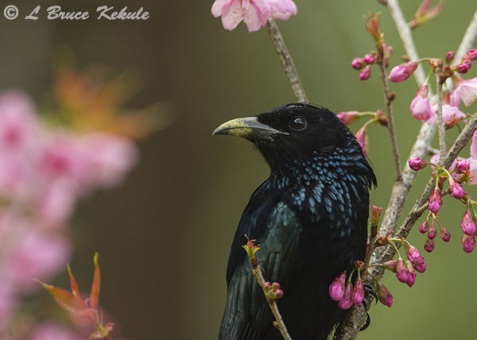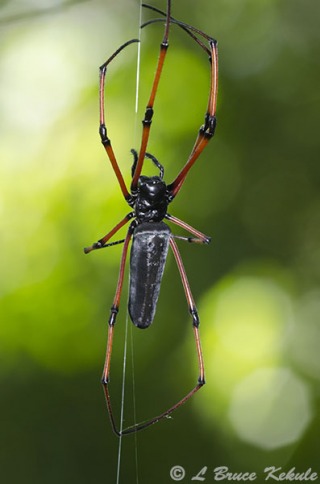Posts Tagged ‘wildlife in Thailand’
Creatures in Thailand’s Western Forest Complex – Part One
Video footage of Thailand’s rare carnivores including tiger, leopard, bear and wild dog. Most of this footage is recent..!
Asian Wildlife through the lens – “Creating conservation awareness through wildlife photography”
THIS POST IS THE FIRST IN A SERIES OF WILDLIFE STORIES THAT WERE PUBLISHED IN THE BANGKOK POST IN THEIR NATURE SECTION: ‘ASIAN WILDLIFE THROUGH THE LENS’. Text and photos © L. Bruce Kekule
“The present government should take a positive interest in preserving what remains of the Kingdom’s natural treasures before it’s too late”
“Before World War II, 75% of the nation was still covered in pristine forests”…!
“What remains is still worth saving”…!
Asiatic jackal by the side of the road in Huai Kha Khaeng
Thailand’s wildlife and forests has evolved over millions of years into some of the most beautiful and interesting in the world. Photographing these ecosystems and rare animals such as the Siamese crocodile, tiger, leopard, gaur, banteng, wild water buffalo, elephant and tapir, plus a multitude of other mammals, birds, reptiles, amphibians, spiders and insects in their natural habitats is a daunting task to say the least. A multitude of different aspects contribute to the difficult and sometimes dangerous pastime of wildlife photography.
Gibbon calling during the morning in Huai Kha Khaeng
Probably the most prominent is the ever-increasing human population and social ills like poaching, gathering and encroachment in the protected areas. This alone has taken its toll and the country’s wild flora and fauna, from under the sea to the highest mountains, are in serious jeopardy with a slim chance of recovery to the magnificent ecosystems of the past. However, not all is lost and the present generation should take a positive interest in preserving what remains of the Kingdom’s natural treasures before it is too late.
Nature photography is one of the best ways to record and promote wildlife conservation awareness. Wildlife photographs create a mental image that can improve one’s love and understanding of the wonderful world of nature. Many people in the cities have a misconception that Thailand’s wildlife and forests has diminished to the point of no return, or has disappeared into the depths of extinction. This is unfortunate and needs constant education and media projection to uplift the people’s knowledge that many species do in fact, still survive.
Sambar with a blue magpie feeding on ticks in Huai Kha Khaeng
Low densities at many sites depleted over the years by poaching and encroachment before any form of protection was implemented is probably one of the main reasons. Human pressure and the Asian traditional medicine trade are directly responsible for the disappearing wild species. The black market trade in wildlife seems to be on the increase and the authorities are continually working to eradicate this destructive illegal business.
Before World War Two, 75 percent of the nation was still covered in pristine forests. Barely 30 percent survives today and most of these are seriously degraded. Wildlife has become scarce and extremely elusive and hence, difficult to photograph. With no subjects, it can be a tough assignment to capture wild creatures that were once quite common. Knowing where to go with the right equipment is just part of the process. Many other aspects are also important and I will try to pass on some of my experiences to those who desire to try their hand at nature/wildlife photography.
Sambar doe on the run in Huai Kha Khaeng
A few protected areas still remain fairly intact with good densities of flora and fauna. Prey species are abundant and carnivores thrive. These havens for wildlife include time honored Huai Kha Khaeng and Thung Yai Naresuan wildlife sanctuaries, Thailand’s top nature reserve and a World Heritage Site. Due to its size (more than 6,000 square kilometers) and biodiversity, this site is absolutely the best tiger habitat left in the Kingdom. It must be saved at all costs for present and future generations.
Kaeng Krachan and Kui Buri national parks further south along the western border with Burma still have very good ecosystems with an abundance of flora and fauna. Other protected areas include: Khao Yai, Thap Lan, Pang Sida national parks in the northeast; Khao Ang Rue Nai and Khao Soi Dow wildlife sanctuaries in the east; Sai Yok, Erawan, Sri Nakarin national parks and Salak Phra Wildlife Sanctuary in the west; Khao Sok National Park, and Khlong Saeng and Khlong Nakha wildlife sanctuaries in the south; and finally, Tarutao National Park and Hala Bala and Budo wildlife sanctuaries in the deep south all have wildlife and make good photographic destinations. However, the security is not too good at the moment and maybe it would be better to wait until things improve for these southern nature reserves.
Gaur herd at a mineral deposit in Huai Kha Khaeng
Wildlife photography is a difficult hobby or profession to become proficient. Years of trial and error, lost shots, bad exposure, out of focus, no wildlife subjects, equipment failure, expense and many other intricate problems make things difficult for the wildlife photographer. Travel plans and permission to enter some of the sensitive protected areas is a hurdle that must be crossed before any photographs can be taken. But where there is a will, there is a way and the difficult can be overcome.
Cameras and lenses in the professional range are expensive but amateur equipment can also provide satisfactory results. Modern technology like the Digital Single Lens Reflex (D-SLR) is now the ultimate and both Nikon and Canon remain the most popular brands for variety (beginner to professional both in lenses and cameras). Other makes like Sony, Pentax, Olympus and Sigma also offer very good equipment. Aftermarket lenses from Sigma, Tamron, and Tokina cost less than the top brands but produce satisfactory to very good photographs.
Spangled drongo in Doi Chiang Dao Wildlife Sanctuary
Another form of wildlife photography is the use of infrared camera traps that allows one to capture illusive and rare animals, plus new digital cameras show results in real time. Readymade camera traps are available and a quick search on the Internet will show dozens of makes and models.
Female tiger camera trapped in Huai Kha Khaeng
The use of a photo-blind is very important as is self-control and patience, which comes with practice and a desire to get a photograph of nature’s creatures. Long stints in the blind and hot weather are something that comes with practice. Wildlife encounters are usually brief and one must always be ready with camera in hand ready to shoot on a moments’ notice.
Black orb spider along a trail in Huai Kha Khaeng
No two days are alike in the natural world and opportunities must be taken then and there if one is to be a successful wildlife photographer. Finally, share your photographs with as many people as possible in order to send a message to all that nature is truly worth saving for the future.
Published in the Bangkok Post on February 27, 2013 in the Life – Nature section…!









